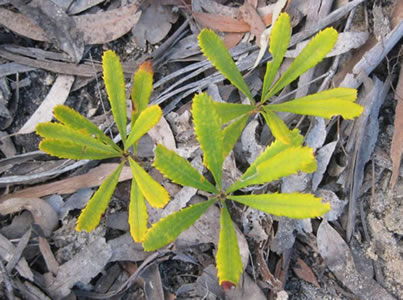
Banksia seedlings dying from Phytophthora cinnamomi infection
Summary of final report on the Australian Flora Foundation funded project:
David Guest, I. Nyoman Aryantha
School of Botany, The University of Melbourne, Victoria 3010
and Rob Cross, Royal Botanic Gardens Victoria, Birdwood Avenue, South Yarra Victoria 3141
May 1997
Results from this project clearly demonstrate that antagonists can reduce Phytophthora cinnamomi dieback severity in Thryptomene calycina in the field as it can in glasshouse pot trials. The addition of compost or compost with antagonists significantly reduces the rate of infection, reduces Phytophthora cinnamomi in the soil, and promotes the growth of Thryptomene calycina.
Phosphonate was shown to protect Thryptomene calycina, Banksia grandis and Banksia spinulosa against Phytophthora cinnamomi in the field. It significantly reduced symptom severity and plant deaths due to Phytophthora cinnamomi without affecting pathogen survival or plant vigour.
Previous studies had shown that compost containing chicken manure was found to be the most effective compost for eliminating Phytophthora cinnamomi, and although this material was suitable for Thryptomene calycina, the phosphorous concentration in the compost was toxic for Banksia grandis and Banksia spinulosa, negating any beneficial effects of antagonists. Further investigations are proposed to determine suitable composts for use with phosphorus sensitive plants like Banksia.
